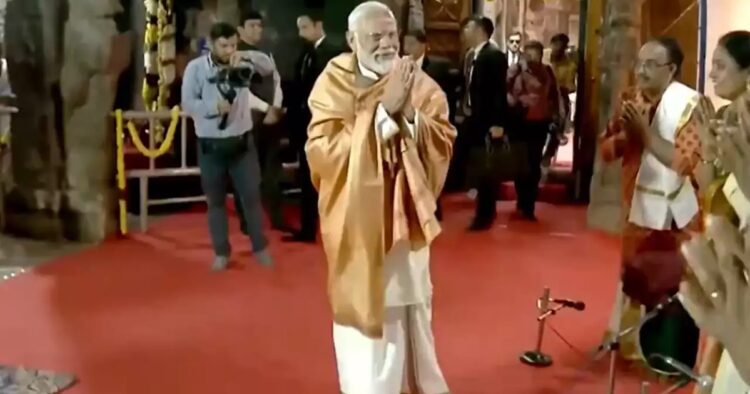In an 11-day special ritual for the consecration of Lord Ram’s idol at the Ayodhya Ram temple, Prime Minister Narendra Modi recently visited significant historical sites linked to the Ramayana. After his visit to the Kalaram Mandir in Maharashtra’s Nashik, PM Modi offered prayers at the Veerabhadra Temple in Lepakshi, Andhra Pradesh.
During the visit, PM Modi engaged in chanting Lord Ram ‘bhajans’ and listened to verses from the ‘Ranganatha Ramayan,’ the Telugu rendition of the Hindu epic. He also enjoyed a puppet show on the Ramayana, sharing images from this spiritual journey on social media.
PM Modi expressed the significance of Lepakshi for devotees of Lord Ram, stating that the Veerabhadra Temple holds great importance. His prayers focused on the well-being and prosperity of the people of India.
Lepakshi’s Role in the Ramayana
Lepakshi, situated in Sri Satyasai district, derives its name from the Telugu phrase ‘Rise, oh bird.’ This name pays homage to Jatayu, the mythical giant vulture-like bird in the Ramayana. According to the epic, Jatayu fought bravely with Ravan when he kidnapped Sita. It is believed that Lepakshi is the area where Jatayu fell after being wounded by Ravan, informing Lord Ram and Laxman about Sita’s abduction.
The town also preserves footprints of Goddess Sita, and Jatayu was granted moksha by Lord Ram at this location. Lepakshi’s ancient temples dedicated to various deities, along with its intricate architecture from the Vijayanagara dynasty, add to its historical significance.
PM Modi’s Visit to Panchavati and Kalaram Temple
Before Lepakshi, on January 12, PM Modi visited the Kalaram temple in the Panchavati area, known for its connection to the Ramayana. According to the epic, Lord Ram, Sita, and Laxman spent the initial years of their 14-year exile in this forest, where the Panchavati area was located. Ravan abducted Sita from this very forest.
The Kalaram temple, reconstructed in 1700 after destruction by the Mughals, holds symbolism in Lord Ram’s victory over demons. The temple’s architecture includes 14 steps, representing the 14 years of Ram’s exile. The idols of Lord Ram, Laxman, and Sita, all made of black stone, portray the narrative of Lord Ram eliminating demons in just 1.5 minutes.
PM Modi, during his visit, offered prayers at the Kalaram temple and listened to verses from the ‘Bhavartha Ramayana’ written in Marathi, showcasing his dedication to the cultural and historical roots embedded in the Ramayana narrative.

















Comments